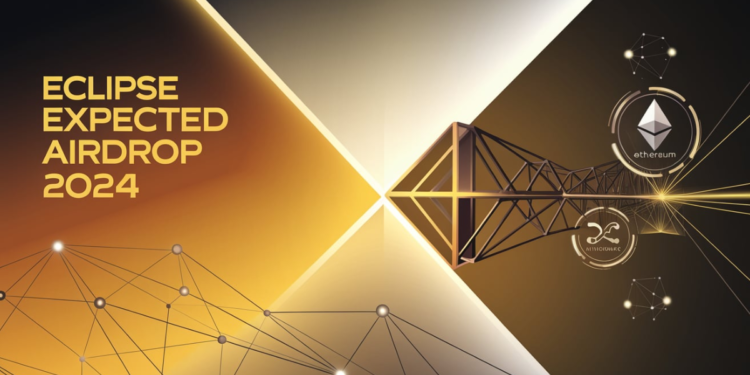The Eclipse expected airdrop in 2024 is drawing attention due to its integration of Solana’s speed with Ethereum’s security, marking it as a significant development in Layer 2 solutions. This Solana on Ethereum Layer 2 network is designed to bring together the best of both ecosystems, offering developers powerful tools for dApps. Early participants who engage with the Eclipse testnet and mint the Path of Discovery NFT stand a chance to be rewarded in the future.
How to Participate in the Eclipse Airdrop
To become eligible for the Eclipse expected airdrop, participants must engage with the Eclipse testnet, completing specific interactions within the network. These steps not only introduce users to Eclipse’s advanced Layer 2 technology but also increase the chances of receiving future rewards from the anticipated airdrop.
Step-by-Step Guide to Airdrop Eligibility
To maximize your chances of qualifying for the Eclipse token airdrop, follow these key steps:
- Set Up an Eclipse Mainnet Wallet
Begin by installing the Eclipse wallet extension. Download the necessary files, enable Developer Mode in your browser, and load the wallet to get started. This wallet will be crucial for bridging funds and interacting with the testnet. - Bridge Funds Using the Owlto Bridge
After setting up your wallet, visit the Owlto Bridge and connect your MetaMask wallet. Here, you will need Sepolia ETH, which can be claimed from faucets like Alchemy or QuickNode. Once acquired, bridge the funds to the Eclipse network, allowing you to interact with its dApps. - Mint the Path of Discovery NFT
Once your wallet is set up and funds bridged, visit the Scope Launchpad to mint the Path of Discovery NFT. This step is crucial for increasing your airdrop eligibility, as early users who engage in this action will likely be prioritized for future token rewards. - Interact with Testnet dApps
Engage with various decentralized applications (dApps) on the Eclipse testnet. This includes performing token swaps, adding liquidity to pools, and participating in Eclipse’s Openbook decentralized exchange. The more you interact with these features, the better your chances of being eligible for the airdrop.
Maximizing Rewards and Future Airdrop Eligibility
To further increase your chances of receiving future rewards, focus on consistent and quality interactions with the Eclipse testnet. Completing multiple transactions, interacting with validators, and using dApps will demonstrate your active participation. Additionally, burning gas fees during transactions can also enhance your airdrop eligibility, as the system often rewards active users who contribute to the network’s growth.
Understanding Eclipse’s Layer 2 Technology
Eclipse is a groundbreaking Layer 2 solution that integrates Solana’s high-speed execution layer with Ethereum’s robust liquidity and security. This innovative approach allows developers to harness the best of both ecosystems, creating a more efficient and scalable environment for decentralized applications (dApps). Eclipse’s focus on parallel execution and cross-chain compatibility makes it a significant player in the Layer 2 space, especially for developers looking to optimize their dApp performance on Ethereum.
Solana Virtual Machine on Ethereum
Eclipse leverages the Solana Virtual Machine (SVM) to drastically improve scalability and transaction speed. Unlike traditional Ethereum Virtual Machines (EVMs), which process transactions sequentially, the SVM enables parallel transaction processing, allowing for thousands of operations to occur simultaneously. This key feature is what gives Solana—and by extension, Eclipse—the ability to handle a higher transaction throughput than other Layer 2 solutions.
For example, while Arbitrum or Optimism may achieve significant scalability improvements, their architecture still relies on sequential transaction processing. In contrast, the SVM’s parallel execution significantly reduces transaction times and costs, making Eclipse an attractive option for dApp developers seeking high-speed performance without compromising on Ethereum’s security.
| Feature | Eclipse (SVM) | Arbitrum (EVM) | Optimism (EVM) |
|---|---|---|---|
| Transaction Speed | High (parallel) | Medium (sequential) | Medium (sequential) |
| Cost | Lower | Moderate | Moderate |
| Security | Ethereum-based | Ethereum-based | Ethereum-based |
| Scalability | High (via SVM) | Medium | Medium |
Benefits for dApp Developers
Eclipse’s Layer 2 setup provides several key benefits for decentralized application developers. By utilizing the SVM on Ethereum, developers can enjoy reduced transaction fees, significantly faster transaction speeds, and the added benefit of trustless access to Ethereum’s liquidity. This unique combination allows for the development of more scalable and efficient dApps without the typical constraints of Ethereum’s gas fees and slower transaction times.
Additionally, Eclipse’s interoperability with both Ethereum and Solana ecosystems opens the door for developers to build cross-chain applications that can tap into the strengths of both networks. For dApp developers, this means access to Solana’s speed alongside Ethereum’s established liquidity pools and user base. In the future, Eclipse’s architecture could also make it easier for developers to create decentralized finance (DeFi) protocols and other high-performance applications.
Related Articles:
The Eclipse expected airdrop in 2024 represents a significant opportunity for developers and early adopters to engage with a powerful Layer 2 solution. By integrating the Solana Virtual Machine with Ethereum’s liquidity, Eclipse has positioned itself as a leading player in the blockchain space. For those interested in building scalable dApps, participating in the testnet, and minting NFTs, Eclipse offers a unique chance to shape the future of decentralized applications while potentially earning rewards along the way.






